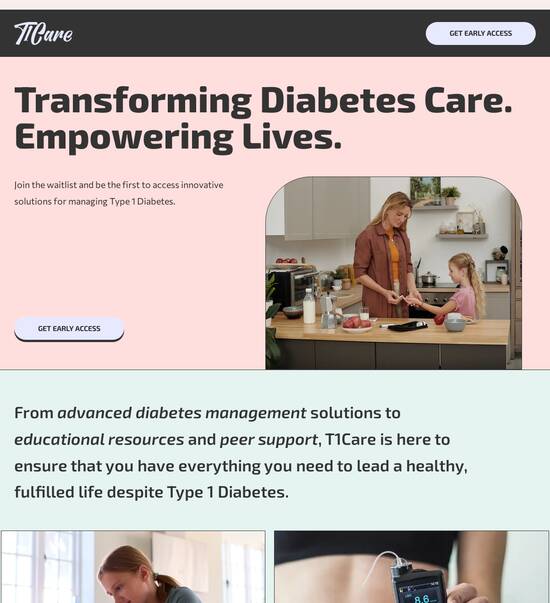
HTML page template for supply chain teams
Use TemplateAbout template
Collaborate and optimize like never before with our landing page templates for supply chain teams. Ready to streamline your workflow?
Recommended templates

Easy to build without coding
With the intuitive drag-and-drop builder, anyone on your team can create high-converting pages without any knowledge of code or design. Make enhancements to your landing page with custom widgets using Javascript, HTML/CSS, or third-party scripts.

Multiple layouts for any industry and goal
Select from 500+ landing page layouts built to boost conversions across industry-specific scenarios. Customize them by adjusting fonts, adding images, and generating on-brand content with the AI assistant. Quickly scale with Instablocks® and Global Blocks that you can save, reuse, and update globally.

Loads fast and looks polished on any device
Every template is responsive, which means they present professionally on any device and load blazingly fast with our Thor Render Engine. You can also power them up with Google AMP technology to deliver an unparalleled mobile experience and drive higher conversions.

Robust analytics & experimentation
Get real-time updates and reporting across all your devices, showing the number of visitors, conversions, cost-per-visitor, and cost-per-lead. Launch AI-powered experiments, run A/B tests, and use heatmaps to analyze user behavior, then optimize your landing page to maximize conversions.







Easy to build without coding
With the intuitive drag-and-drop builder, anyone on your team can create high-converting pages without any knowledge of code or design. Make enhancements to your landing page with custom widgets using Javascript, HTML/CSS, or third-party scripts.
Multiple layouts for any industry and goal
Select from 500+ landing page layouts built to boost conversions across industry-specific scenarios. Customize them by adjusting fonts, adding images, and generating on-brand content with the AI assistant. Quickly scale with Instablocks® and Global Blocks that you can save, reuse, and update globally.
Loads fast and looks polished on any device
Every template is responsive, which means they present professionally on any device and load blazingly fast with our Thor Render Engine.
Robust analytics & experimentation
Get real-time updates and reporting across all your devices, showing the number of visitors, conversions, cost-per-visitor, and cost-per-lead. Launch AI-powered experiments, run A/B tests, and use heatmaps to analyze user behavior, then optimize your landing page to maximize conversions.
All the features you need to build lead-generating landing pages
Explore more featuresLearn how to build top-performing landing pages for any goal
FAQs
Leading the way in building high-performing landing pages





An essential guide to landing page creation using Instapage
Creating high-converting landing pages is a fundamental aspect of digital marketing that can significantly boost your ROI. With Instapage, marketers across various sectors, including business services, tech, education, and government, can leverage powerful tools to streamline their landing page creation process. This guide offers a step-by-step approach to utilizing Instapage effectively, ensuring your marketing campaigns reach their full potential.
Understanding the basics of landing pages
Landing pages serve as dedicated web pages designed to convert visitors into leads or customers. Unlike regular web pages, landing pages focus on a single objective, such as capturing email addresses or promoting a product. Instapage simplifies the creation of these pages with a wide array of customizable templates tailored for varied industries. Here’s why landing pages are crucial:
- Focused messaging: Landing pages communicate a clear value proposition without distractions.
- Higher conversion rates: By targeting specific audiences, landing pages can achieve better conversion metrics.
- Enhanced tracking capabilities: Instapage allows for in-depth analytics and A/B testing to refine marketing strategies.
Step 1: Selecting the right template
Choosing the correct template sets the foundation for your landing page. With over 100 high-converting templates available on Instapage, marketers can easily find a design that resonates with their target audience. Factors to consider include brand alignment, user experience, and conversion goals.
- Template relevance: Select a template tailored to your campaign goals for better alignment.
- Customization options: Ensure the template allows for customization to match your brand's voice.
- Mobile responsiveness: Choose a layout that performs well on both desktop and mobile devices.
Step 2: Optimizing content for conversions
Content is king when it comes to landing pages. Craft compelling headlines, use engaging images, and clear calls-to-action (CTAs) to drive user engagement. Instapage offers dynamic text replacement to personalize content based on the referring ads, enhancing relevance.
- Clear headlines: Headlines should be direct and communicate the unique selling point.
- Engaging visuals: Include images that reflect your offering and connect with your audience.
- Strong CTAs: Use active verbs in your CTAs to encourage users to take immediate action.
Step 3: Testing and optimizing your landing page
After launching your landing page, the work doesn’t stop there. Instapage’s built-in optimization features, including A/B testing and heatmaps, provide insight into user behavior on your page. Use these tools to analyze performance and make data-driven decisions.
Continuous optimization ensures your landing pages not only attract visitors but convert them into valuable leads.
Ready to take your marketing campaigns to the next level? Start utilizing Instapage today to create stunning landing pages that deliver results.
People also ask about HTML page template for supply chain teams
HTML page template for supply chain teams
Understanding the importance of HTML page templates in supply chain teams
In today's interconnected business environment, supply chain teams need to optimize communication and efficiency to stay competitive. HTML page templates serve as a foundational tool that enhances internal processes by streamlining the presentation of critical information. These templates not only standardize design across various platforms but also allow teams to focus on their core functions without getting bogged down by web development intricacies.
The integration of HTML page templates helps to create a uniform look and feel across different communications, such as reports, dashboards, and updates. By ensuring a consistent design, supply chain teams can enhance clarity in their communications. This uniformity fosters a better understanding among team members and external partners, leading to improved collaboration and efficiency in decision-making.
Defining HTML page templates for supply chain applications
HTML page templates refer to pre-designed web pages that allow users to insert content easily. They play a significant role in modern web development by eliminating the need for from-scratch coding for every page. In the supply chain context, these templates can be tailored to fulfill specific requirements, enabling teams to deliver relevant information efficiently.
Streamlined processes ensure that all team members have access to the same resources, reducing miscommunication.
Templates can enhance branding for projects, providing a cohesive look that reflects the organization's identity.
Saves time by allowing team members to focus on more important tasks, such as analysis and strategy development.
Core functionalities of HTML page templates
One of the main features of HTML page templates is their customizable layouts. Supply chain teams can tailor these layouts to meet specific needs, whether that involves displaying inventory levels, shipment tracking, or resource allocation. For instance, a dashboard template can be specifically designed to visualize key metrics, allowing team members to have a quick view of essential data at a glance.
Responsive design is also a critical functionality, considering the need for mobile-friendly access to vital information. Supply chain professionals often work on-the-go, and templates that adapt to different screen sizes ensure that they can access crucial data anywhere, anytime. Techniques such as CSS Flexbox and Grid Layout make it easier to create responsive layouts that adjust seamlessly across devices.
Customizable layouts enhance the relevance of information presented.
Responsive design supports accessibility across various devices.
Built-in SEO optimization increases the templates’ visibility, driving traffic and engagement.
Utilizing document event listeners within templates
Document event listeners are an essential part of interactivity in web applications. In the context of supply chain management, they enable users to engage dynamically with the information presented. For example, when a user clicks on an inventory item, an event listener can trigger a pop-up that provides detailed analytics, contributing to informed strategic decisions.
Furthermore, these listeners can be leveraged for data input tracking. Supply chain teams can benefit significantly from capturing data as team members interact with the templates. This not only aids in data insights but also ensures that workflows are more efficient and responsive. A practical application could be the automatic updating of stock levels across the system when an inventory item is adjusted.
Enhances interactivity by enabling real-time user feedback.
Facilitates a responsive environment for data entry and updates.
Streamlined workflows reduce redundancy in data management.
Loading efficiency: tackling DOMContentLoaded
The DOMContentLoaded event plays a pivotal role in web page efficiency. It indicates that the initial HTML document has been completely loaded and parsed, which is crucial for displaying important supply chain metrics promptly. By handling this event effectively within your HTML templates, you can ensure users see vital information as soon as possible, leading to better user experience.
Understanding how to optimize script execution can further enhance performance. Techniques such as placing scripts at the bottom of the HTML body or utilizing async and defer attributes can ensure that pages load faster. When supply chain professionals access these templates, it’s essential that they do not have to wait long for vital information to appear.
Immediate visibility of essential metrics improves responsiveness.
Utilizing DOMContentLoaded can cut delays in displaying interactive elements.
Optimizing load times can lead to enhanced user satisfaction.
Advanced features for supply chain specific needs
Supply chain teams benefit immensely from advanced features that transform static pages into interactive experiences. Incorporating interactive data visualizations, such as charts and dashboards, can facilitate real-time decision-making. By graphically representing data, teams can analyze trends and patterns effectively, resulting in quicker response times and better resource allocation.
Integrating API endpoints is another powerful feature that enhances the usability of HTML templates. By allowing templates to pull real-time data from supply chain software, teams can stay updated with the latest information. This integration fosters stronger collaboration among supply chain partners and enables data-driven decisions that can directly affect operational efficiency.
Integrating interactive visualizations boosts analytical capabilities.
API endpoints streamline real-time data accessibility.
Data visualizations can significantly influence decision-making processes.
Collaboration and sharing capabilities
Collaboration is key in any successful supply chain operation. HTML page templates can support teamwork by integrating features that allow sharing of information securely. Role-based access controls enable organizations to manage who can view or edit specific content, ensuring sensitive information remains protected while still accessible to relevant team members.
Furthermore, enhancing communication channels within these templates can also facilitate better interaction among team members. By embedding discussion forums, comment sections, and chat functionality, teams can foster an environment of collaboration. This interactivity not only increases engagement but also improves problem-solving speeds, a necessity in fast-paced supply chain environments.
Ensures secure sharing of information enhances teamwork.
Role-based access controls maintain data privacy and integrity.
Enhanced communication within templates fosters a collaborative work environment.
Measuring effectiveness and user feedback
To continuously improve HTML page templates within supply chains, it's vital to monitor their performance effectively. Utilizing analytics tools allows teams to track user interactions and measure engagement with various components of the template. By understanding how team members utilize these templates, organizations can identify areas that require enhancement.
Establishing feedback loops is equally essential for gathering user experiences. Structured methods like surveys or interviews can provide invaluable insights into how templates are performing in real-world scenarios. Engaging supply chain teams in the iterative design process ensures that the templates meet their needs, predicting higher overall satisfaction.
Analytics tools enable focused tracking of template usage.
Feedback loops provide insights for continual improvement.
Engaging users in the design process encourages ownership of content.
Future trends: the evolving role of HTML templates in supply chain management
The future of supply chain management is poised to be shaped significantly by HTML templates. With advancements in AI and machine learning, templates can become more capable of customization based on user preferences. This could manifest as templates adjusting their layouts or features based on historical user interaction, ultimately leading to an enhanced user experience.
Furthermore, the integration of Internet of Things (IoT) data into HTML solutions is on the horizon. Supply chain teams could leverage real-time data from connected devices, providing unprecedented insights into operations. Teams must prepare for these advancements by acquiring new skills and adapting to changing technologies.
AI could allow for personalized experiences within templates.
Incorporating IoT data can revolutionize real-time decision-making.
Skill development will be vital for teams to embrace these innovations.
Real world applications: success stories from supply chain implementations
The practical application of HTML page templates in supply chain settings can be seen in various success stories. For instance, some organizations have employed tailor-made HTML templates to track global shipments, thereby enhancing their visibility into logistics operations. By using interactive maps and dashboards, these templates allow teams to monitor shipments in real-time, significantly reducing delays and enhancing customer satisfaction.
Additionally, other teams have improved their inventory management practices by utilizing HTML templates that automatically update in real time. This allows teams to receive alerts for low inventory levels, automate reordering, and maintain stock with greater accuracy. By leveraging HTML templates in these ways, organizations can expect better operational efficiency.
Case studies highlight improved visibility in global supply chains.
Real-time inventory updates through templates contribute to enhanced resource management.
Success stories provide valuable insights into the practical use of templates.
Best practices for developing and using HTML page templates in supply chains
Creating HTML templates specifically for supply chain applications involves adhering to best practices. First and foremost, ensure that the design is intuitive and user-friendly. Supply chain teams often need to process information quickly, so templates should allow for easy navigation and understanding.
Using reliable tools for dynamic template creation is equally important. Platforms that offer library resources and drag-and-drop interfaces can significantly reduce the development time. Additionally, maintaining compliance and security within HTML frameworks is crucial to protect sensitive supply chain data.
Focus on intuitive design for user-friendly experiences.
Utilize reliable tools for efficient template creation.
Ensure compliance and security to protect sensitive data.
Ready to skyrocket conversions?
Supercharge your ad campaigns with high-performing landing pages
Get started














